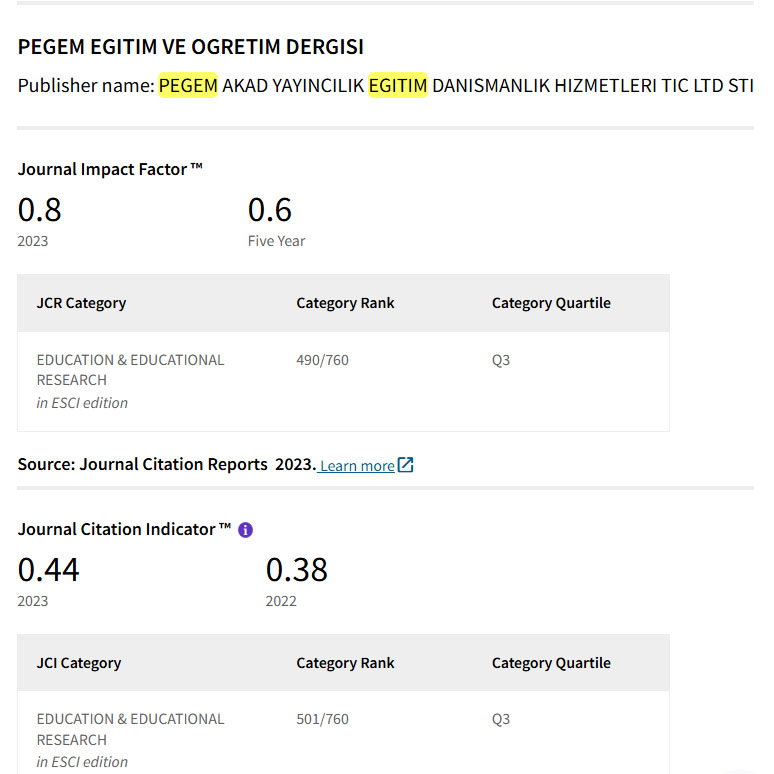Trends of English as medium instruction in science learning: Review and bibliometrıc analysis
DOI:
https://doi.org/10.47750/pegegog.13.01.39Keywords:
bibliometric analysis, EMI, bilingual, science classAbstract
The goal of the research was to provide an extensive bibliometric literature review on 'English as Medium Instruction - EMI' in science classrooms. Articles found by Publish or Perish software (PoP) with a Google Scholar database. There were 999 articles found from the Google Scholar database from 2005 to 2021, but only 996 articles were analyzed in the research. The selected articles were then managed using reference manager software, namely Zotero. After managing the database, the research classified and visualized it using VOSviewer software. Generally, this review provides an appropriate reference point for further research on 'English as a Teaching Intermediate -EMI' in science classrooms. The teaching strategy of EMI bilingually is an option to build mastery of concepts and communication skills for non-native English students in Indonesia. Besides, reading literacy support is also needed for students to improve their mastery of concepts and vocabulary.
Downloads
References
Arkoudis, S. (2003). Teaching English As A Second Language In Science Classes: Incommensurate Epistemologies? Language And Education, 17(3), 161–173. Https://Doi.Org/10.1080/09500780308666846
Artini, L. P. (2011). Persepsi Guru Dan Siswa Terhadap Penggunaan Bahasa Inggris Di Kelas Bilingual Di Sekolah Menengah Atas Berstatus Rsbi Di Bali (Teachers And Students' Perceptions On The Use Of English In Bilingual Class In High School With Rsbi State In Bali). Jurnal Ilmu Pendidikan, 17(4), 307–312. Https://Doi.Org/10.17977/Jip.V17i4.2733
Chou, M.-H. (2018). Speaking Anxiety And Strategy Use For Learning English As A Foreign Language In Full And Partial English-Medium Instruction Contexts. Tesol Quarterly, 52(3), 611–633. Https://Doi.Org/10.1002/Tesq.455
Coleman, J., Hultgren, K., Li, W., Tsui, C., & ... (2018). Forum On English‐Medium Instruction. Tesol …, Query Date: 2021-12-01 11:11:57. Https://Onlinelibrary.Wiley.Com/Doi/Abs/10.1002/Tesq.469
Dearden, J. (2014). English As A Medium Of Instruction – A Growing Global Phenomenon. British Council.
Dearden, J., & Macaro, E. (2016). Higher Education Teachers’ Attitudes Towards English Medium Instruction: A Three-Country Comparison. Studies In Second Language Learning And …, Query Date: 2021-12-01 11:11:57. Https://Www.Ceeol.Com/Search/Article-Detail?Id=430056
Depdiknas. (2006). Menuju Pembangunan Pendidikan Nasional Jangka Panjang 2025 (Towards Long-Term National Education Development 2025). Direktorat Pembinaan Sekolah Menengah Atas - Jakarta.
Dörnyei, Z. (2008). New Ways Of Motivating Foreign Language Learners: Generating Vision. Links, 38, 3–4.
Drubin, D. G., & Kellogg, D. R. (2012). English As The Universal Language Of Science: Opportunities And Challenges. Molecular Biology Of The Cell, 23(8), 1399–1399. Https://Doi.Org/10.1091/Mbc.E12-02-0108
Ducker, N. (2019). English As A Medium Of Instruction. In The Tesol Encyclopedia Of English Language Teaching (Pp. 1–7). John Wiley & Sons, Ltd. Https://Doi.Org/10.1002/9781118784235.Eelt0968
Galloway, N., Kriukow, J., & Numajiri, T. (2017). Internationalisation, Higher Education And The Growing Demand For English: An Investigation Into The English Medium Of Instruction (Emi) Movement In China And Japan. British Council.
Hudha, M. N., Hamidah*, I., Permanasari, A., Abdullah, A. G., Rachman, I., & Matsumoto, T. (2020). Low Carbon Education: A Review And Bibliometric Analysis. Low Carbon Education: A Review And Bibliometric Analysis, 9(1), 319–329.
Khasbani, I. (2019). English As A Medium Of Instruction In Indonesian Primary And Secondary Education: Theory And Reality. Englisia: Journal Of Language, Education, And Humanities, 6(2), 146–161. Https://Doi.Org/10.22373/Ej.V6i2.4506
Kirkpatrick, A. (2012). English As An International Language In Asia: Implications For Language Education. In A. Kirkpatrick & R. Sussex (Eds.), English As An International Language In Asia: Implications For Language Education (Pp. 29–44). Springer Netherlands. Https://Doi.Org/10.1007/978-94-007-4578-0_3
Lauder, A. (2008). The Status And Function Of English In Indonesia: A Review Of Key Factors. Makara Human Behavior Studies In Asia, 12(1), 9–20. Https://Doi.Org/Doi:10.7454/Mssh.V12i1.128
Liu, Z., Yin, Y., Liu, W., & Dunford, M. (2015). Visualizing The Intellectual Structure And Evolution Of Innovation Systems Research: A Bibliometric Analysis. Scientometrics, 103(1), 135–158. Https://Doi.Org/10.1007/S11192-014-1517-Y
Macaro, E., Curle, S., Pun, J., An, J., & Dearden, J. (2018). A Systematic Review Of English Medium Instruction In Higher Education. Language Teaching, 51(1), 36–76. Https://Doi.Org/10.1017/S0261444817000350
Macintyre, P. D., & Macintyre, T. (2012). Affect: The Role Of Language Anxiety And Other Emotions In Language Learning. In Language Learning Psychology: Research, Theory And Pedagogy: Vol. S. Mercer, S. Ryan, M. Williams (Eds.), (Pp. 103–118). Palgrave.
Margana. (2015). View Of Establishing English-Indonesian Bilinguals In Indonesia: From Theory To Practice | Ra Journal Of Applied Research. Ra Journal Of Applied Research, 1(10), 365–374. Https://Doi.Org/Doi : 10.18535/Rajar/V1i10.01
Nilawati Hadisantosa, & Johnstone, R. (2010). Learning Through English: Policies, Challenges And Prospects : Insights From East Asia. British Council.
Rose, H., Curle, S., Aizawa, I., & Thompson, G. (2020). What Drives Success In English Medium Taught Courses? The Interplay Between Language Proficiency, Academic Skills, And Motivation. Studies In Higher Education, 45(11), 2149–2161. Https://Doi.Org/10.1080/03075079.2019.1590690
Sukardi, R. R., Sopandi, W., & Riandi, R. (2021). Can Pupils Retell Concepts In English? An Analysis Of How To Use Emi In Science Class. International Journal Of Instruction, 14(4), 659–678. Https://Doi.Org/10.29333/Iji.2021.14438a
Surdyanto, A. (2018). A Brief View On Bilingual Schools In The Capital Of Indonesia. Ijee (Indonesian Journal Of English Education), 5(1), 1–15. Https://Doi.Org/Doi: 10.15408/Ijee.V5i1.8018
Tranfield, D., Denyer, D., & Smart, P. (2003). Towards A Methodology For Developing Evidence-Informed Management Knowledge By Means Of Systematic Review. British Journal Of Management, 14(3), 207–222. Https://Doi.Org/10.1111/1467-8551.00375
Ünsal, Z., Jakobson, B., Molander, B.-O., & Wickman, P.-O. (2018). Science Education In A Bilingual Class: Problematising A Translational Practice. Cultural Studies Of Science Education, 13(2), 317–340. Https://Doi.Org/10.1007/S11422-016-9747-3
Van Eck, N. J., & Waltman, L. (2010). Software Survey: Vosviewer, A Computer Program For Bibliometric Mapping. Scientometrics, 84(2), 523–538. Https://Doi.Org/10.1007/S11192-009-0146-3
Downloads
Published
How to Cite
Issue
Section
License
Copyright (c) 2022 Pegem Journal of Education and Instruction

This work is licensed under a Creative Commons Attribution-NonCommercial 4.0 International License.
Attribution — You must give appropriate credit, provide a link to the license, and indicate if changes were made. You may do so in any reasonable manner, but not in any way that suggests the licensor endorses you or your use.
NonCommercial — You may not use the material for commercial purposes.
No additional restrictions — You may not apply legal terms or technological measures that legally restrict others from doing anything the license permits.



